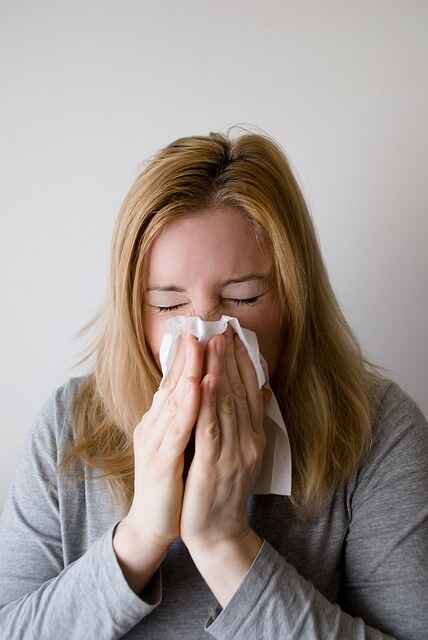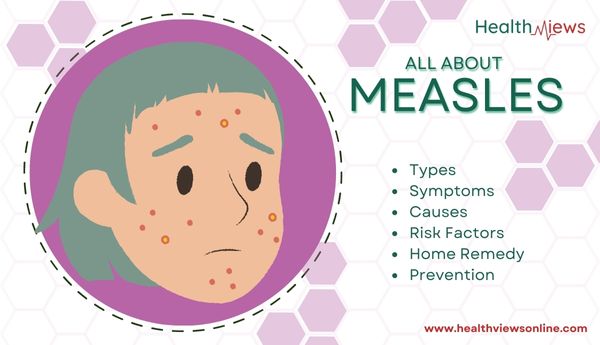What are Measles?
It is a contagious viral illness that typically affects children and causes fever and a red rash. The mucus in the nose and throat harbors the measles virus. It can be contracted by directly touching an infected person as well as through the air. For up to two hours, the virus can remain active on surfaces and in the atmosphere. It spreads rapidly.
Rubeola, another name for measles, is severe, contagious, and can occasionally be fatal in young children. The easiest method to avoid it is to get MMR immunization. Despite the existence of a reliable, effective vaccination, it remains a leading cause of death on a global basis.
Also Read: Lung Cancer: Symptoms, Causes, Risk Factors, Diagnosis, Prevention, Facts
Types of Measles
Measles comes in two different forms. Despite having some of the same symptoms, they are brought on by various viruses:
- The common measles, often known as red measles or hard measles, is brought on by the rubeola virus.
- German measles, often known as rubella, is a completely distinct illness from regular measles and is typically a less serious infection. It is brought on by the rubella virus.
What causes Measles?
Rubeola, is a viral infection found in the nose and throat of an infected adult or child. Measles-transmitting droplets are released into the air when a person coughs, sneezes, or speaks, where they might be inhaled by others. For almost an hour, the contagious droplets can remain in the air.
The virus first infects the respiratory system. It does, however, eventually spread to other parts of the body via the bloodstream. (Source)
The virus can survive on surfaces for up to two hours. You can get it by touching the surface and then rubbing your nose, eyes, or mouth.
It has only been observed in humans, not in animals.

Risk factors
Measles can result in a number of issues, including:
- If measles spreads to other organs like the lungs or brain, it could cause major issues.
- Unvaccinated
- Visit countries where measles is more prevalent
- Can cause pneumonia
- Blindness
- Seizures (fits)
- Vitamin A deficiency
- Ear infection
- Pregnancy complications
- Have an immunodeficiency as a result of another medical condition or treatment
Also Read: All about Eczema: Types, Causes, Risk Factors, Home Remedies, Prevention
Symptoms
The virus multiplies in the back of the throat after infection and starts to slowly travel throughout the body.
Symptoms may appear 10 to 14 days after being exposed to the virus.
Measles symptoms and signs typically include:
- A fever or high temperature
- Cold signs like a runny nose, sneezing, and coughing
- Throat irritation
- Eyes inflamed (conjunctivitis)
- Spots of grey-white inside the cheeks, mouth, and throat
- Nausea
- A skin rash composed of large, flat blotches that frequently flow into one another.
- Tiredness
- Pains and aches

Diagnosis
Contact your doctor right away if you think you may have measles or have been exposed to someone who has it. They can assess you and tell you where to go for treatment if you have an infection.
A doctor can notice signs, such as white spots in the mouth, fever, coughing, and sore throat, by looking at your skin rash.
However, the diagnosis can only be fully verified with a blood or saliva test. These tests examine the levels of the antibodies immunoglobulin M and immunoglobulin G, both of which may reveal the existence of the virus either now or in the past.
Treatment
This skin condition is not specifically treated with any medication. Antibiotics are useless since the illness is viral, not bacterial.
For those who may have been exposed to the virus, there are some interventions available. These can lessen the severity of infection or help prevent one.
They consist of:
- A dosage of immunological proteins known as immunoglobulin, taken after six days of exposure
- A dose of the measles vaccination, administered within 72 hours of exposure
- Your doctor might suggest an antibiotic to help treat any bacterial infections brought on by your measles, such as ear infections or pneumonia.
Home Remedy
You can minimize your measles symptoms at home by:
- Taking plenty of sleep will help your immune system.
- Consuming plenty of liquids, such as water, fruit juices, and herbal teas, to avoid dehydration and ease a sore throat; Caffeine and alcohol should not be taken.
- People with measles, especially youngsters, may benefit from taking vitamin A supplements to lower their symptoms’ severity and the risk of complications.
- A humidifier can soothe a sore throat and cough
- To alleviate eye strain brought by bright lights, wear sunglasses or dim lighting
- NSAIDs that lower fever, like acetaminophen, ibuprofen, or naproxen. Never give aspirin to children.

Can measles be prevented?
The best prevention against measles for both yourself and others is vaccination. The MMR vaccine, which protects against measles, mumps, and rubella, is the most widely used.
If they have never been immunized, adults can ask their doctors for the measles vaccination.
However, there are more ways that you can contribute to the fight against the virus.
- Maintain proper hand hygiene. Before eating, after using the restroom, and before touching your face, mouth, or nose, wash your hands.
- Never exchange personal items with anyone who might be ill. This includes drinking glasses, toothbrushes, and eating utensils.
- Beware of interacting with sick people.
Check out various Skin conditions and all the detailed info on each of them at Skin Problems





